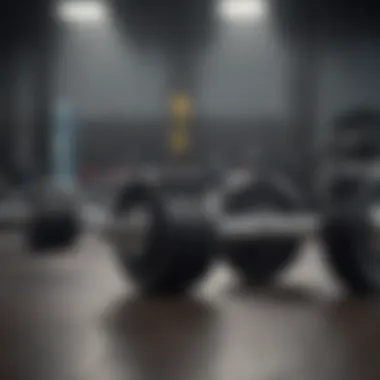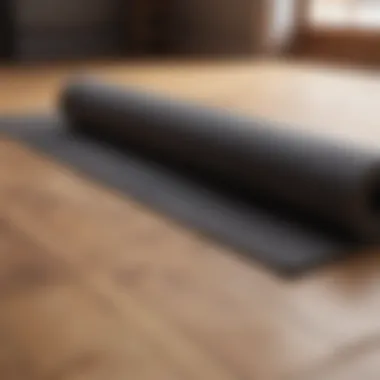Essential Workout Tools for Fitness Beginners


Intro
Starting a fitness journey can be intimidating. A new world opens up, filled with various tools and equipment that promise different advantages. For beginners, the challenge lies in understanding what works best for them. A well-rounded approach to fitness includes not just physical activity but also factors that contribute to overall well-being. In this article, we will explore essential workout tools that beginners should consider.
Wellness Insights
Well-being is not limited to physical health. It encompasses both body and mind. When embarking on fitness, it is crucial to understand how regular exercise impacts well-being.
Benefits of Regular Exercise
Regular exercise has numerous benefits:
- Improves cardiovascular health: Engaging in physical activity strengthens the heart and improves blood circulation.
- Builds strength and endurance: With proper tools, beginners can gradually increase their fitness levels.
- Enhances flexibility and balance: Tools like yoga mats and resistance bands can help improve these areas.
- Boosts mood: Exercise releases endorphins, which can lead to a positive outlook on life.
- Encourages social connection: Group workouts can foster friendships and community.
The benefits extend far beyond physical health.
Understanding Mental Health
Mental health is an integral part of fitness. Exercise can act as a powerful tool for managing stress and anxiety. Engaging in physical activity helps to clear the mind. It is important to note that different tools and practices can enhance this aspect of wellness.
"Exercise is a celebration of what your body can do, not a punishment for what you ate."
Incorporating meditation or mindfulness practices alongside exercise can also deepen the understanding of personal well-being. This approach can help beginners create a balanced fitness routine that addresses both physical and mental aspects of health.
Nutrition Information
Nutrition is equally important to fitness. The body needs proper fuel to perform efficiently. Understanding dietary principles can enhance workout results.
Balanced Diet Essentials
A balanced diet includes:
- Fruits and Vegetables: Packed with essential vitamins and minerals.
- Proteins: Necessary for muscle repair and growth.
- Healthy Fats: Important for energy and overall health.
- Whole Grains: Good source of energy for workouts.
A thoughtful approach to nutrition can lead to better fitness outcomes.
Meal Planning and Preparation
Planning meals helps maintain a balanced diet. Beginners can benefit from quick and healthy recipes. Simple meal prep strategies can include:
- Batch cooking: Prepare meals in advance to save time during the week.
- Snacking wisely: Choose healthy snacks to maintain energy levels.
- Hydration: Drink sufficient water throughout the day to support overall health.
With these insights, beginners can approach their fitness journey with a clearer understanding of how tools, nutrition, and mental health intertwine.
Preamble to Workout Tools
The journey toward fitness is not solely about the workout routines one follows. It significantly hinges on the tools employed during these workouts. Having appropriate workout tools can foster enhancement in performance, improve motivation, and reduce the risk of injury. For beginners, this can mean the difference between feeling overwhelmed and finding a sustainable workout regimen. Choosing the right equipment becomes especially critical as it ensures that workouts are both effective and enjoyable.
Importance of Choosing the Right Equipment
Selecting suitable workout tools is essential for numerous reasons. First, the right equipment tailors the workout experience according to personal needs. For instance, individuals with joint issues may benefit from low-impact options like stationary bikes or resistance bands. This consideration helps in creating a personalized workout environment that responds to physical limitations and capabilities.
Moreover, the correct tools can enhance proficiency in exercise execution. Using dumbbells, for example, can allow beginners to progressively increase the load, thus promoting muscle adaptation over time. Conversely, inadequate equipment can lead to ineffective workouts or injuries. Hence, considering factors like usability, safety, and intended workout goals becomes pivotal.
Not to forget, the visual appeal and brand of the equipment can influence motivation levels. A well-designed treadmill or vibrant resistance bands may make transitioning into a fitness routine more enticing. Recognizing the direct impact of equipment aesthetics cannot be neglected in the broader fitness narrative.
Understanding Your Fitness Goals
Comprehending personal fitness objectives lays the groundwork for selecting appropriate workout tools. Goals can range from weight loss or muscle gain to enhancing endurance or flexibility. Identifying these objectives helps narrow down the equipment that will best serve their purpose.


For instance, if one's aim is to lose weight and improve cardiovascular health, investing in a treadmill or a jump rope could be beneficial. On the other hand, for those focused on strength training, resistance bands or kettlebells may be more aligned with their aspirations.
Furthermore, understanding these goals allows for a tailored approach to incorporating equipment into routines. For individuals seeking strength development, emphasizing dumbbell training will be vital. This alignment between equipment and objectives creates a more focused and effective workout strategy.
By taking the time to define fitness goals clearly, beginners can avoid common pitfalls like purchasing unnecessary equipment. This focused approach saves time and resources while also fostering an intelligent and results-driven fitness journey.
Cardiovascular Equipment
Cardiovascular exercises are a fundamental aspect of any fitness routine, especially for beginners. Engaging in these activities boosts heart health, improves endurance, and aids in weight loss. It is essential to select the right cardiovascular equipment as it can significantly enhance workout efficiency and enjoyment. The right gear not only ensures safety but also encourages consistency, which is vital for a successful fitness journey.
Treadmills: Basic Features and Benefits
Treadmills are one of the most popular choices for cardiovascular workouts. Their basic features typically include adjustable speeds, incline settings, and various workout programs. This versatility allows beginners to customize their routines based on fitness levels. The ability to set a steady pace makes treadmills ideal for walking and jogging, helping users build endurance gradually.
The benefits of using a treadmill are numerous. First, it offers a safe environment where users can exercise regardless of weather conditions. Second, it enables tracking of various metrics like distance, calories burned, and time spent working out. This data can provide motivation and help users set achievable goals. Additionally, modern treadmills often come with features like built-in speakers and heart rate monitors, enhancing the overall experience.
Stationary Bikes: A Low-Impact Option
Stationary bikes present a low-impact alternative to running or jogging, making them suitable for beginners or those with joint concerns. These bikes help to strengthen the legs while minimizing stress on the knees and hips. One can find different styles such as upright and recumbent bikes, each catering to varied preferences and comfort levels.
Using a stationary bike also offers several advantages. It can effectively improve cardiovascular fitness and increase muscle endurance. Additionally, many models come with adjustable resistance levels, allowing users to progressively challenge themselves as they gain strength and stamina. The compact size of stationary bikes makes them an excellent choice for home workouts, saving space while providing effective exercise.
Jump Ropes: Affordability and Portability
Jump ropes are an effective and inexpensive cardiovascular tool. Their simplicity is one of their greatest strengths, as they require minimal space and equipment. This portability makes them perfect for outdoor workouts or traveling, allowing individuals to maintain their workout regimen wherever they go.
Jumping rope can significantly improve cardiovascular health and coordination. A few minutes of rope jumping can yield similar benefits to more prolonged sessions on other equipment. Given its affordability, any beginner can easily incorporate jump ropes into their fitness routine, making it an excellent starting point.
"Jump ropes are not just for children; they are a powerful tool for serious cardio training that fits in your pocket."
In summary, incorporating cardiovascular equipment into a fitness regimen is essential for a balanced approach to health. Whether it is treadmills, stationary bikes, or jump ropes, the right tools can promote consistency, enhance motivation, and contribute to overall well-being.
Strength Training Tools
Strength training tools are fundamental for anyone embarking on a fitness journey. They provide a solid foundation for building muscle strength, enhancing endurance, and improving overall physical performance. For beginners, investing in strength training equipment is essential as it allows for controlled movements and manageable weights. This can be particularly important for gauging one’s capacity and gradually increasing difficulty levels.
Another benefit of these tools is that they engage multiple muscle groups. Incorporating strength training into workout regimes leads to improved muscular stability, posture, and metabolic rate. This is vital not only for aesthetics but also for functional fitness, which promotes better daily performance.
In this section, we will discuss three primary tools: dumbbells, resistance bands, and kettlebells. Each tool has unique advantages catering specifically to beginners.
Dumbbells: Versatility for Beginners
Dumbbells are among the most versatile strength training tools available. They come in various weights, making them suitable for all fitness levels. For beginners, they can be used to perform numerous exercises targeting different muscle groups, including arms, legs, chest, and back.
One of the key advantages of dumbbells is that they allow for an array of movement patterns. For instance, exercises like dumbbell curls can help develop arm strength, while dumbbell squats focus on leg muscles. This variety keeps workouts engaging and promotes balanced development.
Another aspect worth mentioning is the ease of use. Dumbbells are relatively simple to handle. Newcomers can learn proper form and technique without being overwhelmed by complex machinery. Importantly, as strength increases, it’s easy to progress to heavier weights without needing additional equipment.
Resistance Bands: Progressive Workout Options
Resistance bands serve as a unique alternative to traditional weights. They offer adjustable resistance levels, typically categorized by color. This modulation is particularly beneficial for beginners, allowing for gradual strength progression without risking injury.
Using resistance bands can enhance the overall workout experience. They provide constant tension on muscles, making exercises more effective. Furthermore, bands are portable and lightweight, simplifying home workouts or travel fitness routines.
Beginners can appreciate several exercises using bands, such as chest presses, rows, or glute bridges. The bands can be anchored to various surfaces, enabling a wide range of movements. Their versatility ensures that strength training remains varied and enjoyable.
Kettlebells: Functional Strength Building
Kettlebells resemble traditional weights but have a unique shape that allows for different training dynamics. Kettlebell workouts emphasize functional movements, engaging multiple muscle groups in a single exercise. This engagement is particularly advantageous for beginners, as it promotes coordination and balance while evolving strength effectively.
The design of kettlebells encourages natural motions, making them ideal for movements like swings and snatches. These exercises not only help in building strength but also boost cardiovascular fitness. Moreover, as fitness levels improve, kettlebells can be integrated into various high-intensity workouts for added challenge.


Beginners may start with basic lifts and gradually incorporate more complicated movements once they feel comfortable.
"Strength training is not solely about lifting weights. It focuses on building a foundation of strength that aids in daily life and promotes overall well-being."
In summary, strength training tools such as dumbbells, resistance bands, and kettlebells cater to beginners' needs, providing safe and effective ways to build muscle and improve fitness. Understanding how to use each tool effectively can set a solid foundation for a long-lasting workout journey.
Bodyweight Training
Bodyweight training holds significant value in any beginner's fitness routine. Its fundamental nature lies in utilizing one's own weight as resistance. This approach offers various advantages, making it appealing to those new to exercise.
One key benefit of bodyweight training is accessibility. It requires minimal to no equipment, making it easy to get started. Many exercises can be performed almost anywhere, allowing flexibility in practice. This flexibility can increase adherence to a routine as it accommodates various environments such as homes, parks, or gyms.
Another important aspect is the enhancement of functional strength. Bodyweight exercises train multiple muscle groups simultaneously. This not only improves overall body strength but also mimics daily movements. As a result, individuals often find improvements in their functional daily activities, which fosters motivation and a sense of accomplishment.
Moreover, bodyweight training improves balance and coordination. Exercises like squats and push-ups engage core muscles. This is crucial for injury prevention and enhances athletic performance.
Exploring Push-Ups and Variations
Push-ups are among the simplest yet most effective bodyweight exercises. They target the chest, shoulders, and triceps, establishing a solid foundation in upper body strength. Learning the correct form is essential to avoid injury and maximize benefits. A common mistake is failing to keep the body straight throughout the movement.
Variations of push-ups exist to increase difficulty. The decline push-up targets the upper chest more intensely, while the incline version is easier for beginners. Plyometric push-ups add explosiveness, which can enhance strength and power further. These variations can keep workouts dynamic and less monotonous.
The Role of Squats in Workouts
Squats are a cornerstone of bodyweight training. They primarily focus on the lower body, engaging muscles in the thighs, hips, and glutes. Mastery of proper squat technique is vital. Beginners should pay attention to keeping the knees in line with the toes, ensuring that they do not extend beyond them, which can lead to injuries.
Incorporating squats into workouts can have multiple benefits. They help in building lower body strength, essential for other exercises. Additionally, squats can enhance flexibility in the hips and ankles. This increased flexibility can aid in improving overall athletic performance and reduce the risk of injuries as one progresses into more advanced workouts.
Incorporating Planks for Core Strength
Planks play a significant role in strengthening the core, an area often neglected by beginners. A strong core is integral for overall stability and balance, influencing the performance of almost every exercise.
The standard plank requires holding a position similar to the top of a push-up. This position engages not only the abdominal muscles but also the back and shoulders. As an isometric exercise, planks build endurance in the core, which is beneficial for daily tasks and other physical activities.
Various plank variations exist to challenge oneself. Side planks target the obliques more effectively, while plank shoulder taps add movement for a more dynamic challenge. Progressing to these variations can maintain interest and continually improve core strength.
Bodyweight training is a fundamental part of fitness that can empower beginners and facilitate their progress into more advanced routines.
Flexibility and Recovery Tools
Flexible muscles are essential for overall fitness. This section emphasizes the necessity of flexibility and recovery tools as part of a workout routine. These tools help enhance mobility, reduce muscle soreness, and prevent injuries. For beginners, incorporating these tools can be a game changer in sustaining an exercise regimen.
Foam Rollers: Enhancing Recovery Processes
Foam rollers are quite popular among fitness enthusiasts. They are cylindrical tools that provide self-myofascial release. This technique involves applying pressure to muscle knots and tense areas in the body. Using a foam roller can improve blood circulation, which is vital after a workout. When muscles endure stress from exercise, the body needs to recover properly. Foam rollers assist in this process by allowing better muscle recovery and relaxation.
- Benefits of foam rolling include:
- Decreased muscle soreness
- Enhanced flexibility
- Reduced risk of injury
Beginners may feel uncertain about how to use a foam roller. Simple movements such as rolling over the quads, calves, and back can be helpful. Start gently and gradually increase pressure as comfort allows. It is essential to breathe and relax to achieve optimal benefit.
Stretching Straps: Improving Flexibility
Stretching straps are tools designed to facilitate effective stretching. They assist beginners in achieving deeper and more controlled stretches. These straps help extend reach for muscles that might be difficult to flex on their own. Proper stretching promotes better flexibility, which is crucial for performance.
The key benefits of using stretching straps include:
- Improved range of motion
- Enhanced posture
- Reduced muscle stiffness


Users should focus on key areas such as hamstrings, shoulders, and back. Holding stretches for about 20-30 seconds is effective. Consistency with stretching will yield better results over time.
Yoga Blocks: Assisting in Balance and Support
Yoga blocks are often underutilized tools that can greatly enhance a workout routine for beginners. They provide support in various poses, improving alignment and balance. For those who are still building strength and stability, yoga blocks offer a sense of security.
- Benefits of yoga blocks include:
- Greater access to different poses
- Assistance with balance
- Increased comfort during stretches
Beginners can use blocks during a variety of exercises. For example, in a triangle pose or during seated stretches, placing a block can alleviate strain on muscles and joints. This adjustment allows individuals to concentrate on form and technique rather than struggling with flexibility.
This emphasis on flexibility and recovery is crucial for long-term success in fitness pursuits.
The right tools can lead to profound improvements in physical performance and overall health.
Practical Considerations
When beginning a fitness journey, practical considerations play a vital role in determining success. Ensuring that your approach is grounded in reality includes several factors. From budgeting to space management, each aspect can affect your ability to consistently engage in workouts. Taking time to reflect on these considerations helps foster a more sustainable fitness routine.
Budgeting for Workout Equipment
Budgeting is a primary concern for many beginners. Before purchasing any workout tools, it is crucial to establish a clear budget. This will help prioritize expenses and prevent overspending on equipment that may not be necessary.
Here are some key points to consider:
- Identify Priorities: Determine which equipment aligns best with your fitness goals. Not every tool is essential, and focusing on the most beneficial items will make your budget go further.
- Research Options: Look for equipment that fits your price range. Items like dumbbells or resistance bands may offer excellent value without breaking the bank.
- Quality over Quantity: It may be more beneficial to invest in a few high-quality pieces rather than a large number of cheaper items. Quality equipment often lasts longer and improves workout efficiency.
Being mindful of your budget will help you make informed choices and prevent buyer's remorse.
Space Management for Home Workouts
Managing space at home is another critical aspect of setting up a workout environment. Effective space management can lead to a more productive workout atmosphere. Without proper planning, clutter can become a huge distraction. Here are several things to ponder:
- Assess Available Space: Determine how much space you can dedicate to workouts. This should include not just floor space but also areas for storage.
- Multi-Functional Equipment: Consider investing in equipment that serves multiple purposes. For example, a stability ball can be used for both strength training and as a seating option.
- Organized Storage Solutions: Use storage bins or shelves to keep equipment organized. This makes it easy to find items when needed and encourages more frequent workouts.
Efficient space management will lead to a more welcoming home workout environment.
Assessing Equipment Quality and Durability
Choosing the right equipment involves assessing its quality and durability. Poor-quality tools may hinder workout efficiency and could even lead to injury. Therefore, understanding how to evaluate equipment is essential. Here are some aspects that merit attention:
- Material and Construction: Assess the materials used in the construction of equipment. High-quality materials usually result in greater durability.
- Reviews and Recommendations: Reading consumer reviews and seeking recommendations from trusted sources can provide insights into the reliability of a product. Websites like Wikipedia or fitness forums may offer valuable information.
- Warranties or Guarantees: Look for products that offer warranties or satisfaction guarantees. This indicates confidence in the equipment's longevity.
Remember: Each of these practical considerations plays a significant role in crafting a successful and enjoyable fitness journey. Taking the time to address these factors is likely to yield better results in your efforts to improve health and fitness.
End and Next Steps
As one navigates the complexities of beginning a fitness journey, establishing a solid foundation becomes crucial. The conclusion of this article not only wraps up the insights previously shared but also emphasizes the essential actions that need to be taken to continue on this path. This segment outlines the importance of consistent practice and the informed choices regarding workout tools and techniques.
When starting out, it is not about having every piece of gym equipment; rather, it’s about selecting the right tools that cater to individual needs. Keeping focus on personal fitness goals is essential for fostering motivation and achieving results.
Establishing a Consistent Workout Routine
Consistency serves as the backbone of any fitness endeavor. To reap the benefits of workout tools, developing a consistent routine is necessary. A routine helps in forming habits that solidify commitment.
- Set Realistic Goals: Begin with short-term objectives. Gradually work towards long-term aspirations.
- Schedule Workouts: Treat training sessions as appointments. Establish specific days and times. This promotes regular engagement, increasing accountability.
- Track Progress: Use journals or apps to monitor workouts. This feedback motivates and allows for adjustments in training methods.
Different schedules work for different people. Some may thrive with morning workouts, while others prefer evening sessions. Understand personal rhythms and choose wisely. Incorporate diverse workouts that promote enjoyment, this reduces chances of burnout.
Resources for Continuous Learning
Continuous education is vital for personal growth and adaptation in any fitness journey. Knowledge keeps individuals informed about new exercises, techniques, and tools that arise regularly. Here are some recommended resources:
- Educational Websites: Look into resources like en.wikipedia.org and britannica.com for reliable information on fitness and health.
- Online Communities: Engage with forums on reddit.com for shared experiences and tips.
- Books and Courses: Numerous printed or digital materials are available that can expand fitness knowledge. Seek authors known for their expertise in fitness.
- Social Media Platforms: Use facebook.com to follow health and fitness professionals who provide valuable content.
Utilizing these resources not only sharpens understanding but also empowers the individual to make informed choices in their fitness journey. Continuous learning ensures that the commitment remains strong despite challenges encountered along the way.
In summary, this article aims to arm beginners with knowledge and tools necessary for effective workouts. Through careful planning, establishing a routine, and seeking ongoing education, individuals can navigate their fitness journeys more effectively.



